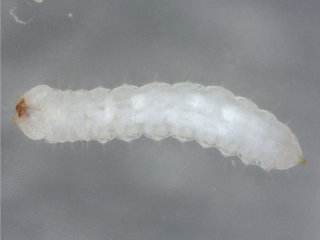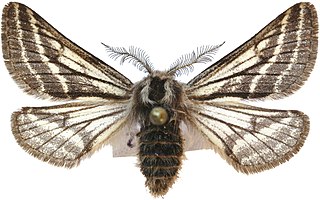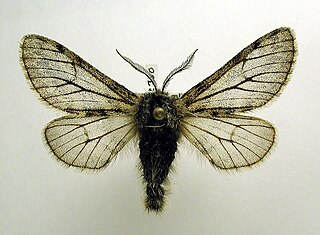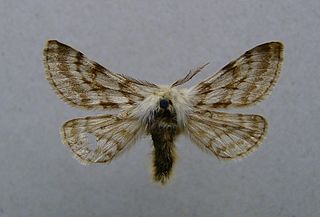
Lycia was a historical region in Anatolia from 15–14th centuries BC to 546 BC. It bordered the Mediterranean Sea in what is today the provinces of Antalya and Muğla in Turkey as well some inland parts of Burdur Province. The region was known to history from the Late Bronze Age records of ancient Egypt and the Hittite Empire.

Olympus or Olympos was a city in ancient Lycia. It was situated in a river valley near the coast. Its ruins are located south of the modern town Çıralı in the Kumluca district of Antalya Province, southwestern Turkey. Together with the sites of the ancient cities Phaselis and Idyros it is part of the Olympos Beydaglari National Park. The perpetual gas fires at Yanartaş are found a few kilometers to the northwest of the site.

The telephone-pole beetle is a beetle native to the eastern United States, and the only living representative of the otherwise extinct family Micromalthidae. Larvae of the beetle live in decaying wood and can be pests to wooden structures, lending them their common name, the 'telephone-pole beetle.'

The common blue butterfly or European common blue is a butterfly in the family Lycaenidae and subfamily Polyommatinae. The butterfly is found throughout the Palearctic and has been introduced to North America. Butterflies in the Polyommatinae are collectively called blues, from the coloring of the wings. Common blue males usually have wings that are blue above with a black-brown border and a white fringe. The females are usually brown above with a blue dusting and orange spots.

Mealworms are the larval form of the yellow mealworm beetle, Tenebrio molitor, a species of darkling beetle.

The brindled beauty is a Palearctic moth belonging to the family Geometridae.

Biston strataria, the oak beauty, is a moth of the family Geometridae. It is native to Europe, the Balkan countries and the Black Sea region as far as Asia Minor and the Caucasus. The species was first described by Johann Siegfried Hufnagel in 1767. B. strataria is found in a variety of habitats, but is mostly found in woodlands where it rests on the bark of trees, camouflaged by its mottled black and grey wings. The male has feather-like antennae while those of the female are more thread-like. The moth has a wingspan of 40 to 56 mm.

Sphinx pinastri, the pine hawk-moth, is a moth of the family Sphingidae. It is found in Palearctic realm and sometimes the Nearctic realm. This species has been found in Scotland but is usually found in England. The species was first described by Carl Linnaeus in his 1758 10th edition of Systema Naturae.

Lycia is a genus of moths in the family Geometridae.

The Harpy Tomb is a marble chamber from a pillar tomb that stands in the abandoned city of Xanthos, capital of ancient Lycia, a region of southwestern Anatolia in what is now Turkey. Built in the Persian Achaemenid Empire, and dating to approximately 480–470 BC, the chamber topped a tall pillar and was decorated with marble panels carved in bas-relief. The tomb was built for an Iranian prince or governor of Xanthus, perhaps Kybernis.

Acraea encedon, the common acraea, white-barred acraea or encedon acraea, is a butterfly of the family Nymphalidae. It is found in sub-Saharan Africa and south-western Arabia. It is one of the species of Acraea sometimes separated in Telchinia.

Lycia zonaria, the belted beauty, is a moth of the family Geometridae. The species was first described by Michael Denis and Ignaz Schiffermüller in 1775 and it is found in most of Europe.

Lycia pomonaria is a moth of the family Geometridae. It is found from central and northern Europe through Siberia to the Kamchatka Peninsula.

Lycia alpina is a moth of the family Geometridae. It is found in the Alps on altitudes between 1,000 and 2,500 meters and in the Jura Mountains.
Coleophora conspersa is a moth of the family Coleophoridae. It is found in Turkey.

Lycia ursaria, the stout spanworm moth or bear, is a moth of the family Geometridae. The species was first described by Francis Walker in 1860. It is found in southern Canada and the northern United States, south to New Jersey and Iowa.

Trebenna (Τρεβέννα) or Trabenna (Τραβέννα) was a city in ancient Lycia, at the border with Pamphylia, and at times ascribed to that latter region. Its ruins are located east of the modern town Çağlarca in the Konyaaltı district of Antalya Province, Turkey. The site lies 22 km to the west of Antalya.

Apollonia was a city in ancient Lycia. Its ruins are located near Kiliçli (Sıçak), a small village in the Kaş district of Antalya Province, Turkey.

Carterocephalus palaemon, the chequered skipper or arctic skipper, not to be confused with the large chequered skipper, is a species of woodland butterfly in the family Hesperiidae. This butterfly can live in grasslands. The upperside of the butterfly is brown with orange spots and on its underside the chequered skipper is orange with brown spots. Chequered skippers are found in Great Britain and other European regions, but seen locally in Japan and in North America. The size of the chequered skipper ranges from 19 to 32 mm with females being larger. In the 1970s, the chequered skipper went extinct in England due to the new management of the woodlands.
Microlechia lycia is a moth in the family Gelechiidae. It was described by Hou-Hun Li in 2001. It is found in Korea and Shaanxi, China.


















